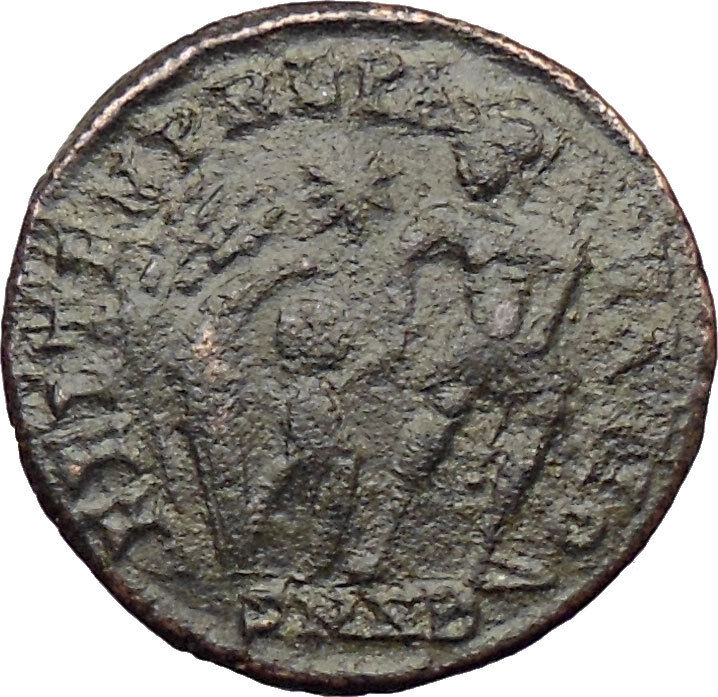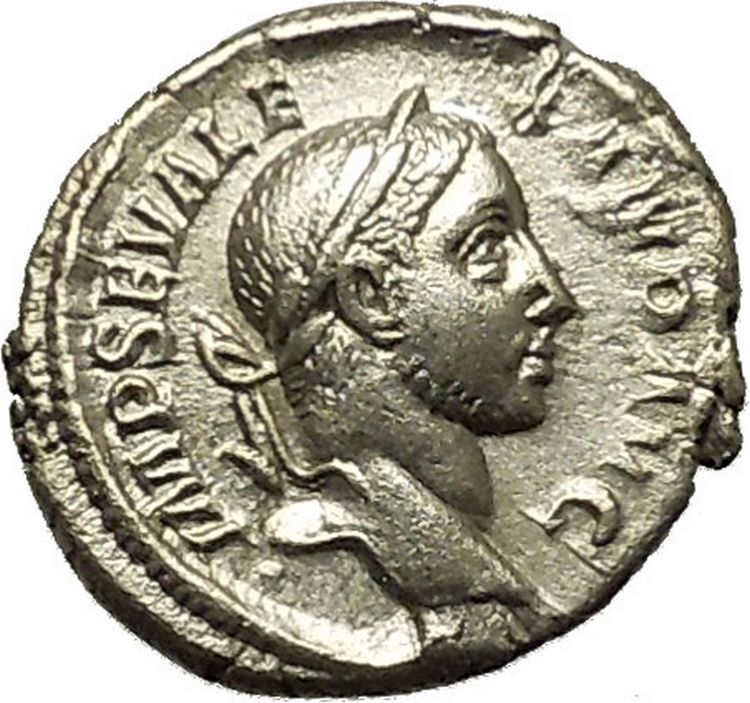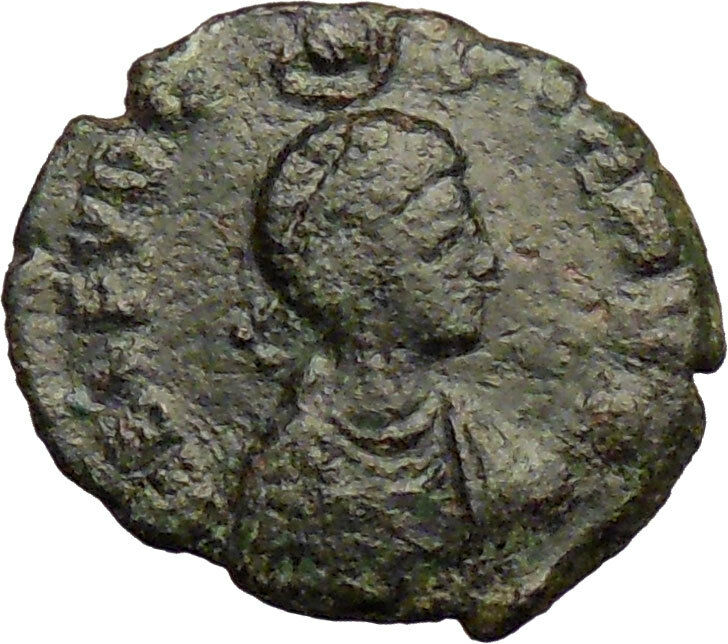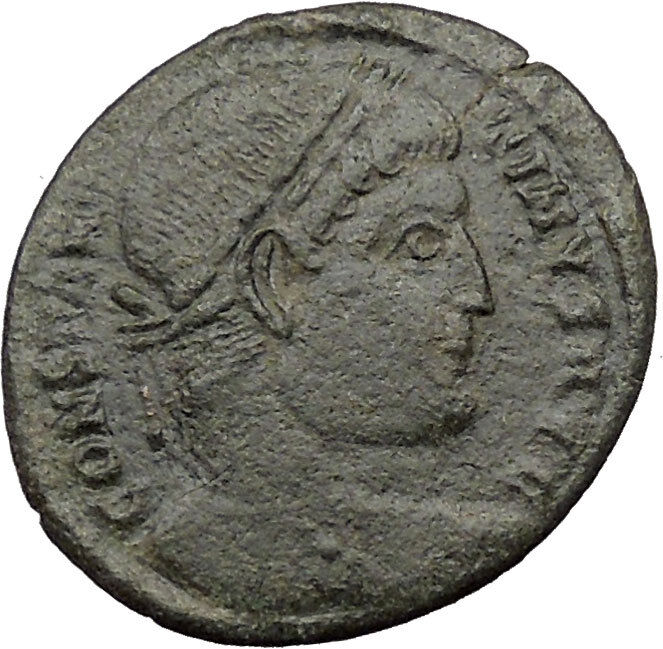|
Constantius I ‘Chlorus’ – Roman
Emperor: 305-306 A.D.
Bronze Follis 28mm (9.45 grams) Siscia mint: 301
A.D.
CONSTANTIVSNOBCAES – Laureate head right.
SACRAMONETAVGGETCAESSNOSTR Exe: B/*SIS – Moneta standing
left, holding scales and cornucopia.
You
are bidding on the exact item pictured, provided with a
Certificate of Authenticity and Lifetime Guarantee of
Authenticity.
The cornucopia (from Latin cornu copiae) or horn of plenty
is a symbol of abundance and nourishment, commonly a large horn-shaped container
overflowing with produce, flowers, nuts, other edibles, or wealth in some form.
Originating in
classical antiquity
, it has continued as a
symbol in
Western art
, and it is particularly associated
with the
Thanksgiving
holiday in
North America
.

Allegorical
depiction of the Roman
goddess
Abundantia
with a cornucopia, by
Rubens
(ca. 1630)
In Mythology
Mythology
offers multiple
explanations of the origin
of the cornucopia.
One of the best-known involves the birth and nurturance of the infant
Zeus, who had to be hidden from his devouring father
Cronus
. In a cave on
Mount Ida
on the island of
Crete
, baby Zeus was cared for and protected by
a number of divine attendants, including the goat
Amalthea
(“Nourishing Goddess”), who fed him
with her milk. The suckling future king of the gods had unusual abilities and
strength, and in playing with his nursemaid accidentally broke off one of her
horns
, which then had the divine power to
provide unending nourishment, as the foster mother had to the god.
In another myth, the cornucopia was created when
Heracles
(Roman
Hercules
) wrestled with the river god
Achelous
and wrenched off one of his horns;
river gods were sometimes depicted as horned. This version is represented in the
Achelous and Hercules
mural painting
by the
American Regionalist
artist
Thomas Hart Benton
.
The cornucopia became the attribute of several
Greek
and
Roman deities
, particularly those associated
with the harvest, prosperity, or spiritual abundance, such as personifications
of Earth (Gaia
or
Terra
); the child
Plutus
, god of riches and son of the grain
goddess Demeter
; the
nymph
Maia
; and
Fortuna
, the goddess of luck, who had the power
to grant prosperity. In
Roman Imperial cult
, abstract Roman deities who
fostered peace (pax
Romana) and prosperity were also depicted with a cornucopia,
including Abundantia
, “Abundance” personified, and
Annona
, goddess of the
grain supply to the city of Rome
.
Pluto
, the classical ruler of the underworld in
the
mystery religions
, was a giver of agricultural,
mineral and spiritual wealth, and in art often holds a cornucopia to distinguish
him from the gloomier Hades
, who holds a
drinking horn
instead.
Modern depictions
In modern depictions, the cornucopia is typically a hollow, horn-shaped
wicker basket filled with various kinds of festive
fruit
and
vegetables
. In North America, the cornucopia
has come to be associated with
Thanksgiving
and the harvest. Cornucopia is
also the name of the annual November Wine and Food celebration in
Whistler
, British Columbia, Canada. Two
cornucopias are seen in the
flag
and
state seal
of
Idaho
. The Great
Seal
of
North Carolina
depicts Liberty standing and
Plenty holding a cornucopia. The coat of arms of
Colombia
,
Panama
,
Peru and
Venezuela
, and the Coat of Arms of the State of
Victoria, Australia
, also feature the
cornucopia, symbolising prosperity.
The horn of plenty is used on body art and at Halloween, as it is a symbol of
fertility, fortune and abundance.
-
Base of a statue of
Louis XV of France
Juno Moneta, an epithet of
Juno
, was the protectress of funds. As such, money in ancient
Rome was coined in
her temple. The word “moneta” had come to mean “money”, “currency”, or “mint” by
the times of writers such as
Ovid,
Martial
,
Juvenal
, and
Cicero
. In
Russian and Polish, “moneta” is the word for “coin.”
As with the goddess Moneta, Juno Moneta’s name is derived either from the
Latin monēre, since, as protectress of funds, she “warned” of instability
or more likely from the Greek “moneres” meaning “alone, unique”, an epithet that
every mother has.

Flavius Valerius Constantius
(March 31 c. 250 – July 25, 306), also Constantius I,
was an
emperor
of the
Western Roman Empire
(305-306). He was commonly
called Chlorus (the Pale)
an epithet given to him by
Byzantine
historians. He was the father of
Constantine the Great
and initiator of the
Constantinian dynasty
.
//
History
The
Historia Augusta
says Constantius was the son of
Eutropius
, a
noble
from northern
Dardania
in modern
Serbia
, and Claudia, a niece of the emperors
Claudius II
and
Quintillus
.
Historians, however, suspect this maternal connection to
be a
genealogical
fabrication
created by his son
Constantine I
, thus connecting his family to two
rather highly regarded predecessors. His father,
however, might have been the brother of Eutropia, wife
of Maximian.
Under the emperor
Carus
, he was governor of
Dalmatia
, and Carus is said to have considered
adopting him as his heir in place of his dissolute son,
Carinus
.
In 293 the emperor
Diocletian
created the
Tetrarchy
, dividing the
Roman Empire
into
Western
and
Eastern
portions. Each would be ruled by an
Augustus
, supported by a
Caesar
. Diocletian became Augustus of the Eastern
empire, with
Galerius
as his Caesar. Constantius was appointed
Caesar to the Western Augustus,
Maximian
, and married
Theodora
, Maximian’s stepdaughter. They had six
children. Constantius divorced his first wife (or
concubine),
Helena
, by whom he already had a son,
Constantine
. Helena was probably from
Nicomedia
in Asia Minor.
He was given command of
Gaul
,
Britain
and possibly
Hispania
.
In 293, Constantius defeated the
forces of
Carausius
, who had declared himself emperor in
Britain and northern Gaul in 286, near
Bononia
. Carausius was killed by his
rationalis
Allectus
, who took command of Britain until 296,
when Constantius sent
Asclepiodotus
, a prefect of the
Praetorian Guard
, to invade the island. Allectus was
defeated and killed, and Roman rule in Britain restored.
Also in 296, Constantius fought a
battle against the
Alamanni
at the city of
Lingonae
(Langres)
in Gaul. He was shut up in the city, but was relieved by
his army after six hours, and defeated the enemy.
He
defeated them again at Vindonissa
(Windisch,
Switzerland
),
thereby strengthening the defenses of the
Rhine
frontier.
Diocletian and Maximian stepped down
as co-emperors in 305, possibly due to Diocletian’s poor
health, and the Caesars, Constantius and
Galerius
, became co-emperors. Constantius ruled the
western empire, Galerius the eastern.
Severus
and
Maximinus
Daia were appointed Caesars. Constantine,
who had hoped to be a Caesar, joined his father’s
campaigns in Gaul and Britain.
Constantius died in Britain, at
York
, in 306, and Constantine was declared emperor
by the army.
Legend
Christian
legends
As the father of Constantine, a
number of Christian legends have grown up around
Constantius.
Eusebius
‘s Life of Constantine claims that
Constantius was himself a Christian, although he
pretended to be a pagan, and while Caesar under
Diocletian, took no part in the emperor’s persecutions.
His first wife,
Helena
, is the subject of many legends, including
the finding of the
True Cross
.
British
legends
Constantius’s activities in Britain
were remembered in medieval British legend. In
Geoffrey of Monmouth
‘s
History of the Kings of Britain
(1136), he is
sent to Britain by the
Senate
after Asclepiodotus, here a British king, is
overthrown by
Coel
of Colchester. Coel submits to Constantius and
agrees to pay tribute to Rome, but dies only eight days
later. Constantius marries Coel’s daughter Helena and
becomes king of Britain. He and Helena have a son,
Constantine, who succeeds to the throne of Britain when
his father dies at York eleven years later.
The identification of Helena as British had previously
been made by
Henry of Huntingdon
,
but has no historical validity: Constantius had divorced
Helena before he went to Britain.
|











